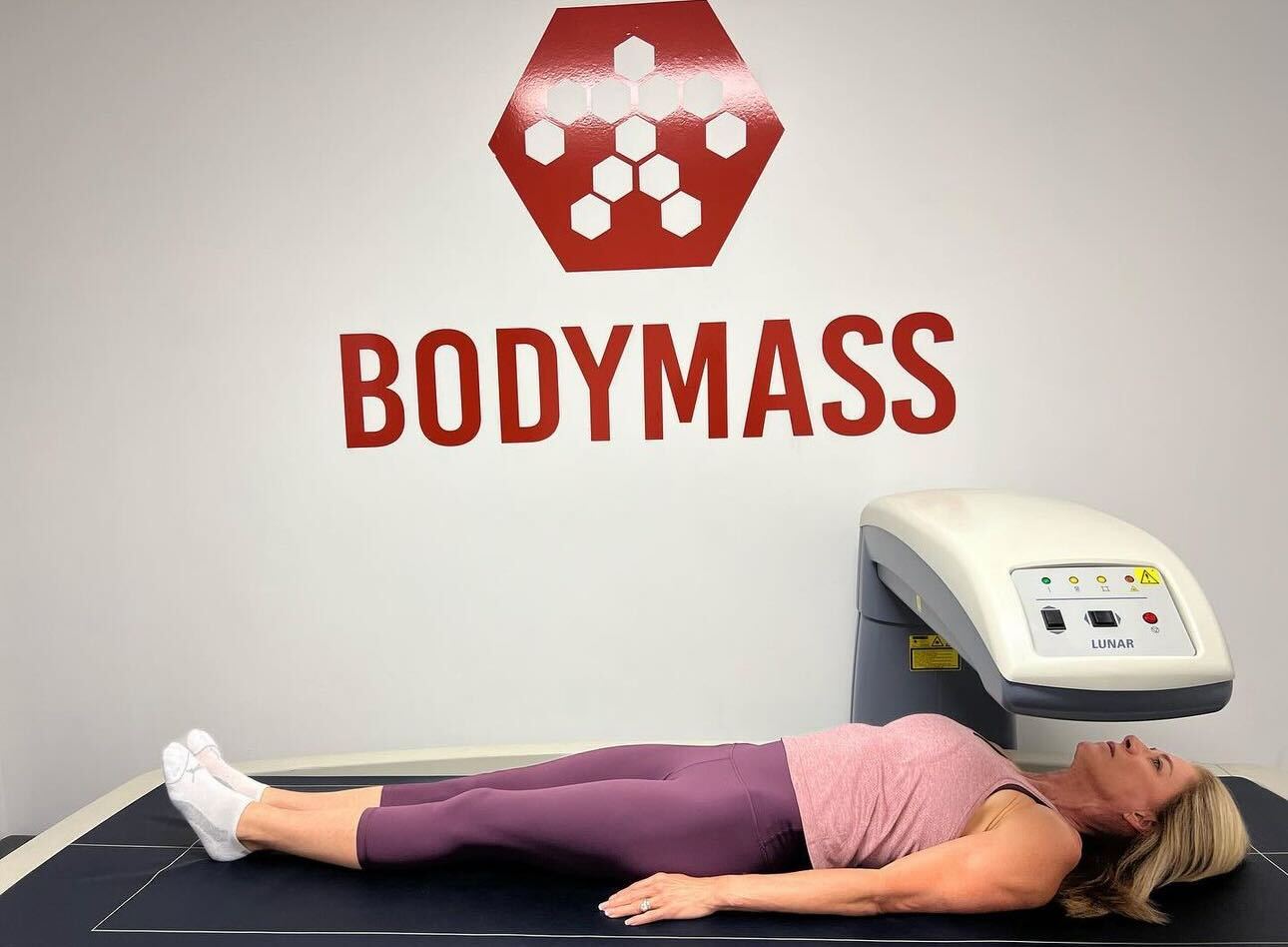Once you turn 40, understanding your body composition becomes essential. Hormonal changes can increase fat gain, particularly visceral adipose tissue, and loss of muscle and bone. Monitoring your body composition helps you take proactive steps to manage these changes, especially during menopause.
A DEXA scan, the gold standard for measuring body composition, provides detailed insights into bone-mineral density, body-fat distribution, and muscle mass.1 Every woman over 40 should consider getting a DEXA scan as it can detect early signs of health issues, enabling prompt action, and helps you create a personalized health plan tailored to your needs.
What Is a DEXA Scan and What Does it Measure?
A DEXA (Dual-Energy X-ray Absorptiometry) scan is a medical imaging test that provides detailed measurements of bone density and body composition. By using two types of X-rays, it distinguishes between bone and soft tissue, offering precise information about body fat, muscle mass, and bone health.
This scan accurately determines how much body fat you have and where it’s located, including fat under the skin and around the organs. Unlike other methods, a DEXA scan delivers comprehensive data, making it invaluable for effectively monitoring and managing your health.
Why DEXA Scan Measurements Are Important
As your hormones start to shift in perimenopause, understanding your body composition and bone health becomes essential. These changes can significantly impact your metabolism and bone density. You’ll want to monitor and manage these factors closely. A DEXA scan can help, offering several key advantages:
- Early detection: Identifies potential issues such as increased risk of osteoporosis, allowing for preventive measures.
- Body-fat distribution: Provides a detailed breakdown, allowing you to adjust your diet and exercise plan to reduce unhealthy visceral fat linked to heart disease and other health problems.
- Muscle-mass insights: Helps tailor your fitness routine to maintain or increase muscle mass, improving metabolism, strength, and overall mobility.
With precise data from a DEXA scan, you can create a personalized health plan, monitor your progress over time, work more effectively with your healthcare practitioner, and make necessary adjustments to stay on track with your health goals.
How to Read the Results
Your DEXA scan report is divided into sections, each with graphs and charts that provide a detailed analysis of your body composition and bone health. Here’s how to interpret it:
Overall Body Score
The Overall Body Score gives a comprehensive view of your health by combining measurements of bone density, body-fat percentage, and lean muscle mass into a letter grade from A to F. This score falls into three main categories:
- Best: Indicates peak health with optimal bone density, low body-fat percentage, and high lean-muscle mass. It suggests excellent overall health and a low risk of chronic diseases.
- Safe: Shows good bone density, moderate body-fat percentage, and adequate lean-muscle mass. This indicates good health but may benefit from minor adjustments in diet or exercise.
- Higher risk: Reveals low bone density, high body-fat percentage, and low lean-muscle mass, signaling a need for significant lifestyle changes to improve health and reduce the risk of chronic diseases and fractures.
Body Composition
Body Fat
A DEXA scan measures the total amount and distribution of body fat, distinguishing between essential body fat and storage body fat:
- Essential fat: Necessary for vital functions, found in bone marrow, heart, lungs, liver, spleen, kidneys, intestines, muscles, and central nervous system tissues.2 For women, essential fat should average 10-13% of total body weight.
- Storage fat: Stored under the skin or around organs, serving as an energy reserve and insulation.3 Too much storage fat can increase the risk of cardiovascular disease and diabetes.4
The optimal body-fat percentage for females varies slightly by age. The recommended range for ages 40-49 is 19-28%. The ideal range for those aged 50-59 increases slightly from 22-31%. For women aged 60 and above, the recommended body-fat percentage ranges from 22-33%.5
Lean Mass
Lean mass includes muscle mass, lean organ mass (the weight of essential organs like your heart, liver, and kidneys), and fluids such as blood and water within cells. Higher lean mass boosts metabolism, strength, and mobility, and lowers the risk of falls and metabolic issues. Maintaining lean body mass also benefits mental health by reducing anxiety and depression and improving cognitive function and sleep quality.6 For women, a healthy lean mass is typically 70-75% of total body weight.
Appendicular Lean Mass Index (ALMI)
The ALMI measures the lean mass in your arms and legs relative to height, indicating muscle health. The average ALMI for women is typically around 6.0 to 7.5 kg/m². An ALMI below 5.67 kg/m² can increase the risk of muscle weakness, reduced mobility, and related health issues.
Fat-Free Mass Index (FFMI)
The FFMI measures your total lean mass relative to height, providing a clearer picture of muscle health. Fat-free mass includes everything except for fat, such as muscle mass, bone mass, water, organs, and connective tissues. An FFMI above 15 indicates healthy muscle development, while an FFMI of 18 and above is above average. Conversely, an FFMI below 15 may indicate lower muscle mass.
Visceral Fat
Visceral fat, stored around internal organs, is particularly dangerous because it is metabolically active, releasing harmful substances that cause inflammation and insulin resistance. Unlike subcutaneous fat, visceral fat directly impacts the function of vital organs like the liver, pancreas, and intestines, increasing the risk of cardiovascular diseases and metabolic issues like insulin resistance.7, 8
A DEXA scan measures visceral fat on a scale from 0 to 5:
- Level 0-1: Very low visceral fat, minimal risk of health.
- Level 2-3: Moderate visceral fat, manageable health risk.
- Level 4-5: High visceral fat, a significant risk for heart disease and diabetes.
Android/Gynoid Ratio (A/G Ratio)
The A/G Ratio compares fat distribution in your abdominal area (android fat) to the fat in your hips and thighs (gynoid fat). A higher ratio indicates more abdominal fat, a risk factor for metabolic diseases. For women, an A/G ratio should be below 1.0, ideally between 0.6 and 0.8.
Bone Density
DEXA scans provide detailed measurements of bone density, crucial for assessing bone health. As you age, your bones lose density, making them more fragile and prone to fractures. This loss of bone density can lead to conditions like osteoporosis, significantly increasing your risk of breaks and injuries from falls.9
Bone Mineral Content (BMC)
Bone Mineral Content (BMC) measures the total amount of minerals in your bones, such as calcium and phosphorus. These minerals are crucial for bone strength and density. Ideal BMC values for women are generally 2.5-3.0 kg (5.5-6.6 pounds).
T-score
A T-score compares your bone density to that of a healthy young adult:
- Great: A T-score of 0 or above indicates excellent bone density. Any T-score above 0 shows that your bone density exceeds the average peak bone density of a healthy young adult. For example, a T-score of 2.5 is considered exceptional.
- Normal: A T-score between -1.0 and 0 indicates normal bone density.
- Osteopenia: A T-score between -1.0 and -2.5 indicates lower than normal bone density, a condition called osteopenia, which suggests a risk for developing osteoporosis.
- Osteoporosis: A T-score below -2.5 indicates osteoporosis.
Bone Mineral Density by Body Part
The scan provides bone density measurements for specific areas such as the spine, hips, and forearms, each accompanied by a T-score. This helps assess fracture risk and overall bone health.
What to Do With Your DEXA Scan Results
When you receive your DEXA scan results, taking specific actions based on the findings is essential. Here are some suggestions, especially if you’re concerned about low bone-mineral density or body composition:
- Monitor progress: To consistently track your body composition at home, use a body-composition scale and regularly measure your waist-to-hip ratio. These tools provide valuable daily insights into your body-fat percentage, muscle mass, and fat distribution. A reliable body composition scale, like this Oxiline bioimpedance scale, offers a quick snapshot of these changes. Additionally, the MyoTape Body Measure Tape is perfect for accurately measuring your waist-to-hip ratio, a simple yet effective way to assess fat distribution and potential health risks.
Schedule DEXA scans every six months to monitor significant changes and fine-tune your action plan for a comprehensive view. Consistency is key—using the same machine and technician each time ensures reliable and comparable results. - Incorporate resistance training: Resistance training benefits both bone health and body composition. This exercise stimulates bone growth, increasing bone density and reducing the risk of fractures. Additionally, resistance training builds muscle, improves strength, boosts metabolism, and enhances fat burning, contributing to a healthier body composition.
My FREE Resistance Training Cheat Sheet provides everything you need to build and maintain muscle, including home gym essentials, an 8-week workout plan, and a progress tracker to monitor your sets, reps, and weights with each workout.
- Eat protein first: Eating 30-50g of protein per meal helps you feel fuller longer, reduces cravings, promotes bone health, and supports muscle maintenance, aiding in fat loss.

Optimal Body Composition Starts with Protein
Increasing your protein intake is essential for improving bone health, promoting fat loss, and enhancing overall body composition—key areas highlighted by your DEXA scan results. Most of us don’t get enough protein, but making one simple dietary change can be a game changer: eat protein first.
My 7-Day Eat Protein First Challenge makes this change easy. You’ll get a protein calculator to determine your daily protein needs—the results may surprise you! Plus, you’ll receive a guide packed with tips, tricks, and a protein-first meal plan to help you transition to a higher-protein diet and enjoy its numerous benefits.
References:
- Morgan SL, Prater GL. Quality in dual-energy X-ray absorptiometry scans. Bone. 2017 Nov;104:13-28. doi: 10.1016/j.bone.2017.01.033. Epub 2017 Jan 31. PMID: 28159711.
- Healthline: Types of Body Fat: Benefits, Dangers, and More
- Healthline: Types of Body Fat: Benefits, Dangers, and More
- The University of Kansas Health System: The Truth About Heart Disease and Diabetes
- WebMD: Body Composition: Health and Body Fat
- Healthline: 14 Benefits of Strength Training, Backed by Science
- WebMD: Visceral Fat: Why It’s Dangerous and How to Lose It
- Castro AV, Kolka CM, Kim SP, Bergman RN. Obesity, insulin resistance and comorbidities? Mechanisms of association. Arq Bras Endocrinol Metabol. 2014 Aug;58(6):600-9. doi: 10.1590/0004-2730000003223. PMID: 25211442; PMCID: PMC4423826.
- Cleveland Clinic: Visceral Fat: What It is & How to Get Rid of It
These statements have not been evaluated by the Food & Drug Administration. Products mentioned are not intended to diagnose, treat, cure, or prevent any disease. The views in this blog by JJ Virgin should never be used as a substitute for professional medical advice. Please work with a healthcare practitioner concerning any medical problem or concern.






